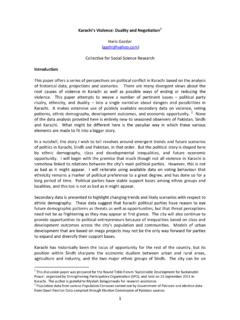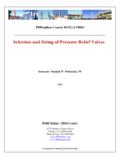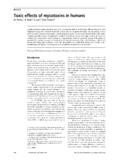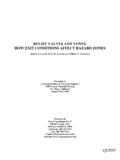Transcription of Case Study: Dumping of Hazardous Industrial …
1 Environmental Policy & Urban Pollution Case study : Dumping of Hazardous Industrial waste In Adnan Millwala and Erum Haider July 2006 This report is based on investigations carried out by the authors for the Collective on environmental hazards in poor localities of Karachi. The investigation consisted of interviews of affected individuals and families, community profiles of affected communities, a review of media reporting, and physical inspections of accessible relevant areas. The report documents a case of alleged Industrial pollution in the SITE area that led to the death of one child, and serious injuries to numerous children and adults this year. The aim of this preliminary study is to identify important lacunae in the maintenance of environmental standards, and possible areas for future policy advocacy, community mobilisation and research.
2 The authors are grateful to Mr Nawab Ali and Mr. Noor for acting as resource persons during the research. The views expressed in this report are those of the authors alone. Collective For Social Science Research 173-I, Block 2, , Karachi- 75400, Pakistan. Website: Tel: 4551482; Fax: 4547532 Table Of Contents Overview Of Current Introduction Geographical Details of the waste Site Important Stakeholders And Their Involvement Community Profile Different Localities That Were Affected By the Incident Spatial Analysis With Respect to the waste Site Community and Household Details of Some of the Affected Families Collective Action Within the Communities Gender Information Asymmetry Health and Environmental Injured/ Affected Children Details of treatment Environmental Concerns for the Community Chemical Report Details Other Environmental Concerns Problems of Access and Issues in the Responses Gaps in the System- Strengths & Weaknesses Lessons Learnt & Questions for
3 Further Research Overview Of Current Events Introduction The Sindh Industrial Trading Estate (henceforth SITE) was designated as an Industrial Area in 1963. is one of the oldest and the largest Industrial areas of Pakistan, encompassing approximately 4700 acres (19 km ) of Home to thousands of small and medium enterprises as well as large manufacturing factories, SITE has over the years attracted a large number of migrant labourers from all over Pakistan. Migrating largely from areas in and Punjab, and also from different parts of Sindh, the workers soon established squatter settlements around the vicinity of the Industrial areas. These unauthorised settlements soon evolved into complete housing colonies and have also over time gained legitimacy in the eyes of the state.
4 Earlier this year around January-February 2006, a factory in the SITE area of Karachi allegedly dumped Hazardous chemical waste in an empty plot (F620-621) within the vicinity of SITE Town. The Dumping of this waste subsequently led to several serious and minor injuries of young boys who are residents of the surrounding areas. Over a period of three months, a total of 20 such cases have been recorded where mainly children from the nearby areas have been seriously injured in the Hazardous waste material. Of the injured, one child, Iftikhar, also died (28th April 2006) due to the severity of his burns, while another, Shiraz, has had both his legs amputated and has lost his fingers as well.
5 The rest are still undergoing treatment and those with relatively more serious wounds will take several more months to heal. The family members of the injured children initially thought that their children had been burnt in the garbage set on fire by rag pickers in the area. However, later upon learning that it was actually the toxic chemical waste that had been responsible for their children s condition, they grew more concerned and willing to take action against the offenders. 1 Wikipedia on SITE The incident has come to light primarily after Iftikhar s death after which, at the request of the community, the media took notice of the situation. On the 4th of May 2006, a social worker from the community, Alam Zeb Tanoli, got in touch with a private channel Geo and apprised them of the toxic waste and resulting accidents and death.
6 The Geo team promptly visited the locality and aired a news item on the issue; soon after which almost all the print and electronic medias were carrying this news. Only after the incident had received media publicity did the governmental agencies take notice and spring into action. As per reports in various leading newspapers, such as the Ummat, Jang, Dawn, The News and Daily Times, Adviser to the Chief Minister Sindh for Environment, Alternate Energy and Technology Mr. Noman Saigal visited the affected area and prompted the police and Sindh Environment Protection Authority into action. The police soon recorded statements from the affected families and formally filed a report. The Managing Director of the Sindh Environmental Protection Agency (SEPA), Iqbal Saeed Khan accompanied by Deputy Director, SEPA, Ishfaq Peerzada, visited the empty plot to confirm the presence of the Hazardous waste and soon after that visited the SITE Police Station to lodge a FIR (#181/06) against the unknown offenders.
7 The cases were reported under the Qisas and Diyat Ordinances (QDO) 285, 286, 322 of the Pakistan Penal Code (PPC)2. He also collected samples of the Industrial waste and sent them to the Industrial Analytical Centre at the HEJ Research Institute of Chemistry, University of Karachi. The report as quoted in the newspapers, confirmed the high levels of toxicity present in the waste material and identified certain toxic chemicals that are banned in Industrial processes. Upon confirming the details of the incident, the police investigated into the matter and interrogated the owner of the plot Mr. Syed Nehal Ahmed. Syed Nehal Ahmed, however, informed them that he had leased out the plots F620 and F621 to Mr. Salman and Mr.
8 Abdur Rehman respectively, last year. When the police went to arrest them, both these individuals had already in advance procured bail against their warrants. 2 Bail Documents for Farooq Garib and Sher Khan Additionally, on the 8th of May 2006, the police moved to arrest the owners of Garib Sons (Pvt.) Ltd., the company allegedly responsible for Dumping the Hazardous waste . The Director Farooq Garib and his Manager, Aslam Baig, were duly arrested from the office of SITE Ltd.; In addition to them, the contractor and owner of the dumper Sher Khan, responsible for transporting the waste to its designated site, was also arrested.
9 After a remand for three days, all three of them were released on a bail of ,000 each. The members of the community confirmed that Noman Saigal had ordered the immediate sealing of the factory that had been involved in this unfortunate incident. Though this was done, local residents believed that due to Farooq Garib s familial connections with a high-ranking military official, the factory was almost immediately reopened. The Human Rights Commission of Pakistan (HRCP) also launched an investigation into the matter and has demanded the immediate arrest of those responsible for this transgression. While initially, the FIR had been lodged under the names of Iftikhar, Shiraz, Naveed and Gul Siddiq, as being affected by the waste ; HRCP ensured that the names of the other 20 children injured, be also included as part of the FIR.
10 In response to these events, a team of social activists in the area mainly, Qazi Khizr, Khalid Shah, Nawab Ali and Noor along with a few others started to investigate the issue and visiting the homes of the affected families. In a meeting organised by the HRCP they, with the consent of the affected families and community members, managed to form the Saneha SITE Action Committee (SSAC). The purpose of such a committee was to channel all subsequent legal action through one platform and to provide a unified front in dealing with the offenders. The SITE Association, composed largely of the leading industrialists in SITE, came forward, after the media reports, to help the affected families.






